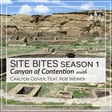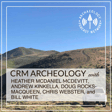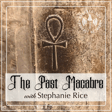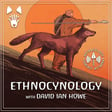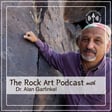Become a Creator today!Start creating today - Share your story with the world!
Start for free
00:00:00
00:00:01

Introduction to Season 1: Canyon of Contention With Rob Weiner - Intro
For the first season of the Site Bite’s Podcast, we will be exploring Chaco Canyon archaeology with this season’s featured co-host, Rob Weiner. Rob is a Ph.D. candidate in Anthropology at the University of Colorado Boulder. He talks about his passion for Southwest archaeology and his current research. This pre-season episode was recorded after Rob and Carlton had finished recording all five episodes for season 1. They reflect on the experience of recording all five episodes in one day and also express how excited they are for this season’s content.
Episode numbers, titles, and featured guests:
- What is Chaco? Location, Features, and Chronology with Dr. Rich Friedman
- Origins of Chaco - Who were the Chacoans? Where did they come from? With Dr. Cathy Cameron
- Major Debates in Chaco Archaeology with Dr. Paul Reed
- What happened to Chaco? Theories on depopulation and “Collapse” with Dr. Steve Lekson
- Indigenous Chaco - Descendant communities perspectives with Patrick Cruz
Carlton Shield Chief Gover
- Email: pawneearchaeologist@gmail.com
- instagram: @pawnee_archaeologist
- Twitter: @PaniArchaeology
- Website: https://www.colorado.edu/anthropology/carlton-gover
Robert Weiner
- Robert.weiner@colorado.edu
- Instagram: @chacoroadsproject
Affiliates
Transcript
Introduction: The Canyon of Contention
00:00:00
Speaker
You're listening to the Archaeology Podcast Network.
00:00:14
Speaker
Welcome to the season one opener of Sight Bites Podcast. For this season, we will be exploring Chaco Canyon archaeology in the season that we are dubbing, The Canyon of Contention.
Meet Robert Weiner: Passion for Chaco Canyon
00:00:28
Speaker
My future co-host for season one is Robert Weiner, a fellow PhD student here at the University of Colorado, Boulder. And Rob, would you please introduce yourself?
00:00:38
Speaker
You got it, Carlton. Well, I want to say thank you for inviting me to do what is probably my favorite thing in the world, which is talk about Chaco Canyon. Let's see. I grew up in New Mexico. I was born in Santa Fe and visited a lot of archaeological sites growing up and was always fascinated. And from about the age of seven,
00:00:58
Speaker
I never had any other idea for what I wanted to do besides be an archaeologist. So here I am. The first
From Mediterranean to Chaco: A New Focus
00:01:05
Speaker
time I went to Chaco Canyon was a very impactful experience. Just being in that landscape under those crystalline clear skies and seeing these monumental towering buildings really stuck with me. But because I had grown up in New Mexico and the archaeological sites there were kind of too close to home, I initially started my archaeological
00:01:28
Speaker
academic investigations in the mediterranean i was very interested in late bronze age i did some work in southwestern turkey learned hit tight there's a life skill anyway after a while became you know i still love the mediterranean stuff but i became more interested in
00:01:45
Speaker
the archaeology of Chaco and realized that some of the approaches and ways of thinking I'd been introduced to working in the Mediterranean could shed interesting new light on this fascinating archaeological site so close to home.
Chaco's Architectural Wonders and Rob's Research
00:02:01
Speaker
In brief, Chaco is a place with massive buildings. Pueblo Benito, the largest building in Chaco, was the largest building in North America until apartments were built in Chicago in the 1800s.
00:02:15
Speaker
eight something like 800 rooms, four stories, and there's 12 of these massive buildings in Chaco Canyon. Many of them are associated with 30 foot wide roads that go shooting out across the landscape. And these are the focus of my PhD dissertation here at the University of Colorado Boulder.
00:02:33
Speaker
I'm doing the first large scale study of the roads since the 1970s and asking where do they go? The answer is most of the time they go nowhere, at least to the sort of conventional ways that in the modern world we think about roads. Most of them appear to be more religious features and they just point towards important landforms or sometimes roads will connect sites.
00:02:57
Speaker
across eras connect sites that were occupied and hundreds of years apart and so people tying back to their ancestors. The features associated with them appear to be large scale intentional breakage of pottery as some sort of practice of offering a lot of fire features likely related to ritual and they sort of control movement through these great house landscapes which seem to be sites of religious or ceremonial usage more than sort of large scale habitation.
Preview of Future Episodes on Southwest Archaeology
00:03:27
Speaker
In one of the episodes, we'll get into a, you know, here an alternative perspective that great houses were something more like apartments, but the evidence I've worked with and that my dissertation is exploring is really the intense focus on religious architecture and specifically these monumental massive roads in the Chaco world.
00:03:46
Speaker
Yeah, thank you for that, Rob. And as you all can tell, Rob is a up and coming archaeologist here in the Southwest, specifically in Chaco, which is why he is our featured co-host. This is his bread and butter in terms of research and passion. And so he's here to help me guide this dialogue along, because even though I am also a PhD student,
00:04:05
Speaker
I work in the Plains, so I have the background, but I might not know the specifics of what's going on in the Southwest. And as Rob has alluded to about what's coming up in this season, we have five episodes, each featuring a different professional in Southwest archaeology, along with my featured co-host, Rob Weiner.
00:04:24
Speaker
recorded all five episodes today. We started at 9 30 a.m. Mountain time and is now seven o'clock. So we're actually doing this season one intro after we recorded all five episodes. And we go from basic background about the Chaco region, indigenous perspectives, what happens after Chaco once Chaco loses its prominence in the Southwest, including talking about, as Rob said, some some debates in archaeology where he does some verbal sparring with one of his colleagues.
00:04:52
Speaker
How
Behind the Scenes: Creating the Podcast
00:04:53
Speaker
do you think today's recordings went, Rob? And what can our listeners expect from this season of Site Bites? I truly thought they went very, very well. We had some incredibly informed and articulate guest speakers, and we really got introduced to a wide variety of questions and ideas and perspectives and competing hypotheses about the ancient past at Chaco. And I think people can really look forward to
00:05:20
Speaker
learning something about a time period and a location that so often in the popular imagination is sort of the mysteries of the Southwest and Chaco Canyon and you see these massive masonry buildings, but we don't think about it as a history, as real people and real events with their own lives and their own
00:05:42
Speaker
changes and developments over time. And so people can look forward to hearing about the fact that the ancient Southwest was a fascinating place, not just where people were growing corn and moving here and there because the climate dried up, but a really rich and complicated past with, as some would say, nobles and commoners, multi-storied buildings, astronomy,
00:06:08
Speaker
questions about how many people are living in this site. So we're really going to get a glimpse into an unknown world in the ancient Southwest that has a history not often told.
Guest Speakers: A Diverse Lineup
00:06:20
Speaker
Excellent. I would absolutely agree with your analysis of today. I've learned so much having the privilege to sit with you as my co-host, but we had the privilege of
00:06:32
Speaker
also interviewing Dr. Kathy Cameron, recently retired from CU Boulder, Dr. Steve Lexin, also recently retired from CU Boulder, Patrick Cruz, as well as Rich Friedman, and Paul Reed. So we had a really diverse background, both academics and non-academics, to talk about the complexity of Chaco archaeology and the archaeology of the Outlying Region.
Resources and Contacts
00:06:55
Speaker
And for everyone in your episode descriptions, if you want to contact me or Rob or have suggestions for sites that we can investigate in later seasons, you can find our email addresses and contact information in the episode descriptions, wherever you're listening to this podcast, as well as additional reading material. We mentioned a lot of different sources where we're getting our information from, right? And so we've provided the articles, both
00:07:19
Speaker
academic and popular media that we're drawing these interpretations from. So if you find yourself fascinated by the content that we talk about in these episodes, we have additional readings for you, which can open your eyes as well as the contact information for our guests. So if you want to get in contact with them, tell them how much you like the episode or ask questions, it's there for you.
00:07:39
Speaker
Rob, thank you so much for being my featured co-host here for season one. I am looking forward to the release of this podcast and I hope everyone at home, whether you're listening at work in your car or back at home, that you find this podcast to not only be informational, but as well as entertaining. So we
Acknowledgments: Production Team
00:07:57
Speaker
hope you enjoy this season and we look forward to seeing you in future seasons to come. Thank you very much.
00:08:12
Speaker
This episode was produced by Chris Webster from his RV Traveling America, Tristan Boyle in Scotland, in the Archaeology Podcast Network, and was edited by Chris Webster. This has been a presentation of the Archaeology Podcast Network. Visit us on the web for show notes and other podcasts at www.archpodnet.com. Contact us at chris at archaeologypodcastnetwork.com.
